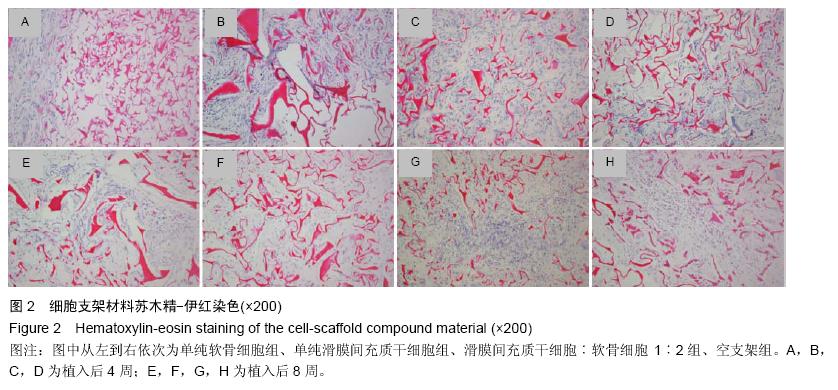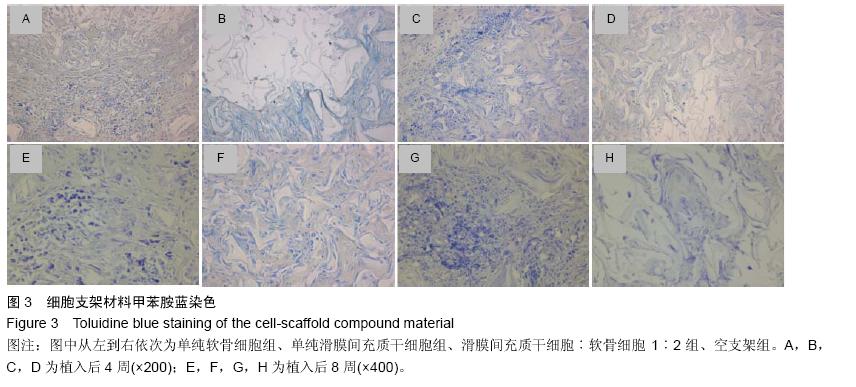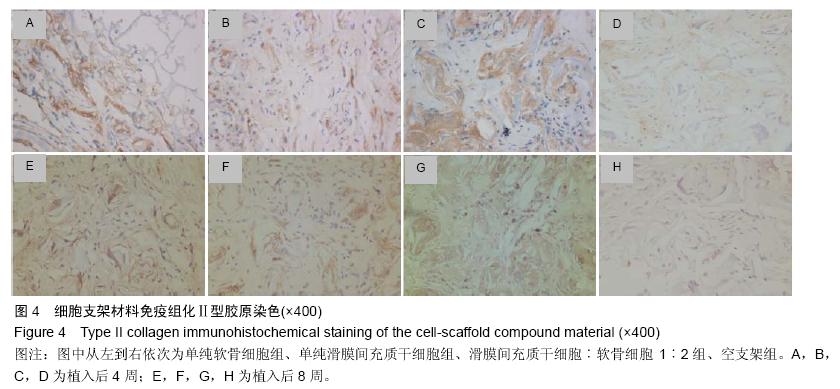| [1] Segawa Y, Muneta T, Makino H, et al. Mesenchymal stem cells derived from synovium, meniscus, anterior cruciate ligament, and articular chondrocytes share similar gene expression profiles. J Orthop Res. 2009;27(4):435-441.[2] Shi X, Wang Y, Varshney RR, et al. In-vitro osteogenesis of synovium stem cells induced by controlled release of bisphosphate additives from microspherical mesoporous silica composite. Biomaterials. 2009;30(23-24):3996-4005.[3] Klein TJ, Malda J, Sah RL, et al. Tissue engineering of articular cartilage with biomimetic zones.Tissue Eng Part B Rev. 2009;15(2):143-157.[4] Sakaguchi Y, Sekiya I, Yagishita K, et al. Comparison of human stem cells derived from various mesenchymal tissues: superiority of synovium as a cell source. Arthritis Rheum. 2005;52(8):2521-2529.[5] Yoshimura H, Muneta T, Nimura A, et al. Comparison of rat mesenchymal stem cells derived from bone marrow, synovium, periosteum, adipose tissue, and muscle Cell Tissue Res. 2007;327(3):449-462.[6] Jansen JA, Vehof JW, Ruhé PQ, et al. Growth factor-loaded scaffolds for bone engineering. J Control Release. 2005;101(1-3):127-136.[7] Park H, Temenoff JS, Holland TA, et al. Delivery of TGF-beta1 and chondrocytes via injectable, biodegradable hydrogels for cartilage tissue engineering applications. Biomaterials. 2005;26(34): 7095-7103.[8] Harrison BS, Eberli D, Lee SJ, et al. Oxygen producing biomaterials for tissue regeneration. Biomaterials. 2007;28(31):4628-4634.[9] Bouten CV, Dankers PY, Driessen-Mol A, et al. Substrates for cardiovascular tissue engineering. Adv Drug Deliv Rev. 2011;63(4-5):221-241.[10] Solchaga LA, Gao J, Dennis JE, et al. Treatment of osteochondral defects with autologous bone marrow in a hyaluronan-based delivery vehicle.Tissue Eng. 2002; 8(2):333-347.[11] Sui Y, Clarke T, Khillan JS. Limb bud progenitor cells induce differentiation of pluripotent embryonic stem cells into chondrogenic lineage. Differentiation. 2003; 71(9-10):578-585.[12] Blunk T, Sieminski AL, Gooch KJ, et al. Differential effects of growth factors on tissue-engineered cartilage. Tissue Eng. 2002;8(1):73-84.[13] Ball SG, Shuttleworth AC, Kielty CM. Direct cell contact influences bone marrow mesenchymal stem cell fate. Int J Biochem Cell Biol. 2004;36(4):714-727.[14] Paschos NK, Brown WE, Eswaramoorthy R, et al. Advances in tissue engineering through stem cell-based co-culture. J Tissue Eng Regen Med. 2015; 9(5):488-503.[15] 邵博,龚忠诚,刘慧,等.大鼠来源滑膜间充质干细胞的成软骨分化[J].中国组织工程研究,2014,18(15):2338-2344.[16] 宁晓婷,邵博,龚忠诚,等.滑膜间充质干细胞与软骨细胞三维条件下混合培养向软骨细胞的分化[J].中国组织工程研究,2014,18(34):5434-5440.[17] 龚忠诚,魏丽丽,吴杨,等.滑膜间充质干细胞软骨分化能力的实验研究[J]. 新疆医科大学学报,2010,33(1):22-25. [18] 龚忠诚,龙星,林兆全,等.壳聚糖/l型胶原复合支架材料制备及其性能的研究[J].新疆医科大学学报,2009,32(12): 1670-1674[19] Ichinose S, Muneta T, Koga H, et al. Morphological differences during in vitro chondrogenesis of bone marrow-, synovium-MSCs, and chondrocytes. Lab Invest. 2010;90(2):210-221.[20] Nakamura T, Sekiya I, Muneta T, et al. Arthroscopic, histological and MRI analyses of cartilage repair after a minimally invasive method of transplantation of allogeneic synovial mesenchymal stromal cells into cartilage defects in pigs. Cytotherapy. 2012;14(3): 327-338.[21] Kurth T, Hedbom E, Shintani N, et al. Chondrogenic potential of human synovial mesenchymal stem cells in alginate. Osteoarthritis Cartilage. 2007;15(10):1178- 1189.[22] Miyamoto A, Deie M, Yamasaki T, et al. The role of the synovium in repairing cartilage defects. Knee Surg Sports Traumatol Arthrosc. 2007;15(9):1083-1093.[23] Shirasawa S, Sekiya I, Sakaguchi Y, et al. In vitro chondrogenesis of human synovium-derived mesenchymal stem cells: optimal condition and comparison with bone marrow-derived cells. J Cell Biochem. 2006;97(1):84-97.[24] 周敏,徐淑兰,钟星华,等.壳聚糖一I型胶原复合膜的制备及其生物相容性实验研究[J].广东牙病防治,2012,20(4): 193-198.[25] 詹兴旺,韦曙东,姜艳,等.胶原-壳聚糖支架与软骨细胞的生长[J].中国组织工程研究与临床康复,2011,15(38): 7090-7094.[26] 陈红丽,晏杰,张彤,等.胶原-壳聚糖复合材料作为组织工程支架的研究[J].国际生物医学工程杂志,2010,33(4): 197-200.[27] 张永强,任志鹏,杨自权,等.I型胶原-壳聚糖复合材料的生物相容性研究[J].生物骨科材料与临床研究,2011,8(2): 3-7.[28] 王征,马云胜,穆长征,等.胶原蛋白复合壳聚糖支架的制备及生物学性状:壳聚糖及胶原比例筛选[J].中国组织工程研究与临床康复,2010,14(29):5367-5370.[29] Benders KE, van Weeren PR, Badylak SF, et al. Extracellular matrix scaffolds for cartilage and bone regeneration. Trends Biotechnol. 2013;31(3):169-176.[30] Chen WC, Yao CL, Wei YH, et al. Evaluating osteochondral defect repair potential of autologous rabbit bone marrow cells on type II collagen scaffold. Cytotechnology. 2011;63(1):13-23.[31] Fischer J, Dickhut A, Rickert M, et al. Human articular chondrocytes secrete parathyroid hormone-related protein and inhibit hypertrophy of mesenchymal stem cells in coculture during chondrogenesis.Arthritis Rheum. 2010;62(9):2696-2706.[32] Bian L, Zhai DY, Mauck RL, et al. Coculture of human mesenchymal stem cells and articular chondrocytes reduces hypertrophy and enhances functional properties of engineered cartilage. Tissue Eng Part A. 2011;17(7-8):1137-1145. |
.jpg)



